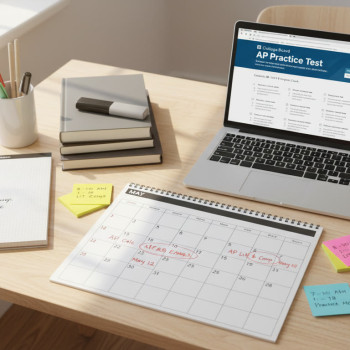Why This Guide? A Note to Parents
If your child is in the thick of AP Macroeconomics, AP Microeconomics, or AP Statistics, you already know: the stakes feel real, the material can be abstract, and the calendar moves faster than you expect. This guide is written for you — the parent who wants to help without taking over, who wants to provide calm structure, smart resources, and encouragement that actually lands.

Big Picture: What Each Course Tests And Why It Matters
Before diving into tactics, let’s anchor in the differences. AP Macroeconomics looks at the economy as a whole: GDP, inflation, unemployment, monetary and fiscal policy, and international trade. AP Microeconomics focuses on the individual pieces — consumers, firms, markets, elasticity, and market structures. AP Statistics is a toolkit for making sense of data: sampling, probability, inference, regression, and interpretation.
Understanding these distinctions helps you and your teen prioritize study time. Macroeconomics and Microeconomics are conceptual and graph-heavy; Statistics asks for procedural fluency and sound interpretation of data and inference. Exam formats vary (multiple choice plus free response), so practice and timing matter.
Quick Comparison Table: Content, Skills, and Typical Exam Shape
| Course | Core Focus | Key Skills Tested | How to Prepare |
|---|---|---|---|
| AP Macroeconomics | National economy, policy, growth, inflation, money | Graph interpretation, model application, quantitative reasoning | Practice graphs, connect concepts to current events, time-based drills |
| AP Microeconomics | Individual markets, elasticity, consumer/producer behavior | Supply/demand analysis, optimization, comparative statics | Diagram practice, problem sets, short-answer explanations |
| AP Statistics | Data collection, inference, probability, regression | Procedure selection, calculation, interpretation of results | Hands-on labs, practice with data, simulation and calculator fluency |
Start With A Realistic Timeline: From Now To Test Day
One of the most powerful things you can do as a parent is help your teen build a realistic timeline. Break the remaining months into focused, manageable phases: Foundation, Reinforcement, and Polish. The specifics depend on how far out the exam is — but the structure is stable.
- Foundation (Weeks 1–6): Identify weak spots, master vocabulary and core graphs/formulas, and build a weekly rhythm.
- Reinforcement (Weeks 7–14): Increase question volume, alternate between multiple choice and free-response practice, and simulate timed sections.
- Polish (Final 4–6 Weeks): Full-length practice exams under realistic conditions, review common traps, and finalize test-day logistics.
How Much Time Per Week?
For a student taking a single AP economics or statistics course: 4–8 hours/week outside class is a strong target. If they’re juggling more APs, aim for 3–5 hours per course. Quality beats quantity: focused, uninterrupted sessions with clear goals are far more effective than long, tired study marathons.
Practical Weekly Structure
Use a repeating weekly template so your teen knows what to expect and progress becomes visible.
- 2 Concept-Focused Sessions (45–60 mins): Deep dive on a unit (e.g., price elasticity, or sampling distributions). Use whiteboard or paper to draw and explain.
- 1 Practice Session (60 mins): Timed multiple-choice or freestanding FRQ practice — focus on pacing.
- 1 Review Session (30–45 mins): Mistake analysis: create an error log and turn misconceptions into a one-page cheat sheet.
- Weekend Full-Length Practice (Every 2–3 weeks): Simulate test conditions. Review thoroughly after.
Study Techniques That Actually Work
These study techniques are chosen because they map directly to AP assessment styles and long-term retention.
Active Retrieval Over Passive Reading
Flashcards, whiteboard recaps, and doing problems without looking at solutions force retrieval. This works especially well for vocabulary and definitions in economics, and for formula recall and the steps of hypothesis testing in statistics.
Interleaving and Spaced Practice
Rotate topics each session — don’t spend two days in a row on only one concept. Mixing micro and macro problems, or moving between inference and regression topics in Stat, helps students learn to choose the correct tool rather than rely on pattern recognition tied to a problem’s surface features.
Mistake Logs and Mini-Explanations
When a practice problem is missed, have your teen write a one-paragraph explanation of the error and how to fix it. Explaining aloud (to you, to a tutor, or in a recorded voice memo) strengthens understanding and reveals gaps.
Graphing By Hand — Then Digitally
For Macro and Micro, sketching supply and demand, AD/AS, or cost curves by hand is crucial for intuition. Then, use a calculator or simple software to confirm. For Stats, hand-drawing a distribution before calculating helps tie reasoning to numbers.
Free-Response Strategies: Turn Short Answers Into Points
The free-response section is where many students leave points on the table. Scoring rubrics reward clear, direct reasoning — not long essays.
- Label everything: In macro and micro, label axes and curves and make sure you indicate shifts and final equilibrium points.
- Answer the question asked: Begin every FRQ with a one-sentence thesis (e.g., “The unemployment rate would likely rise during a recession because…”).
- Show work in stats: Write hypothesis statements, show test statistics, and provide confidence intervals rather than just a conclusion.
- Practice partial credit: If stuck, state the principle and describe expected direction of change — graders award points for correct reasoning even if arithmetic is off.
Calculator and Tech Habits
AP exams have specific calculator policies and expectations. For Statistics, comfort with your student’s approved calculator is non-negotiable: know how to run regressions, calculate summary statistics, and simulate randomization tests if needed. For Macro and Micro, basic calculations and graphing tools are often sufficient, but the real skill is interpreting results.
When To Bring In Extra Help
Not every student needs weekly tutoring, but there are clear signs that extra help will pay off:
- Persistent misconceptions after targeted practice (e.g., mixing up nominal vs. real variables, or confusing Type I vs. Type II errors).
- Low practice test scores but high effort — when study techniques haven’t closed the gap.
- Timing issues on practice tests: runs out of time frequently or can’t structure FRQs quickly.
Personalized tutoring can correct course more efficiently than more hours alone. For example, Sparkl’s 1-on-1 guidance and tailored study plans give students focused feedback on the exact skills they need to shore up — a smart investment when practiced problems aren’t translating to improved scores.
How To Support Your Teen Without Becoming The Teacher
Parents often want to help but can unintentionally create pressure or dependency. Here are gentle, high-impact ways to help.
- Be the logistics manager: Handle calendars, test-day registration checks, and quiet study spaces.
- Ask process questions not answers: Instead of “Do you know supply shifts?” try “Show me how you would test that idea on a practice question.”
- Celebrate small wins: Improved timing, cleaner graphs, or one fewer careless error are worth noticing.
- Encourage rest and balance: Sleep, movement, and brief social time help memory consolidation and reduce burnout.
Practice Test Days: Run Them Like the Real Thing
Full practice exams are the single best predictor of how a student will perform. Treat practice days like test days: timed sections, no phone, and the same tools allowed on exam day. Afterward, spend double the time reviewing — drills alone don’t help unless errors are analyzed and corrected.
Checklist For A High-Value Practice Exam
- Simulate timing and breaks exactly.
- Use only allowed materials and calculators.
- Score immediately and create an action plan for the next week focused on missed question types.
- Record three takeaways: what went well, what surprised you, and the top three things to fix.
Concrete Mini-Plans: 4-Week Focused Boosts
Below are two compact 4-week plans you can adapt if an exam is coming fast. They’re intentionally targeted to maximize score gains quickly.
4-Week Plan For AP Macro/Micro (Intensive)
- Week 1 — Strengthen fundamentals: graphs, key formulas, and vocabulary (daily 45–60 minute sessions).
- Week 2 — Timed multiple-choice practice and focused concept reviews for weakest units.
- Week 3 — FRQ drills: practice writing clear, labeled answers; timed long FRQs twice that week.
- Week 4 — Two full practice exams, targeted review on errors, light walk-throughs the day before exam.
4-Week Plan For AP Statistics (Intensive)
- Week 1 — Master distributions, sampling, and the logic of inference (practice calculator functions).
- Week 2 — Focus on hypothesis testing and confidence intervals; do mixed sets of MCQ and free-response.
- Week 3 — Regression and multivariable thinking; interpret output and practice context-based conclusions.
- Week 4 — Two full practice exams, emphasis on showing work and interpreting results in sentences.
Real-World Connections That Make Concepts Stick
Link abstract ideas to everyday life. Talk about inflation using grocery prices, or use sports ticket pricing to explain supply and demand. In statistics, use news polls or social media data to practice interpreting margins of error and sampling issues. These concrete anchors turn definitions into mental models that are easier to retrieve under pressure.
Mindset: Confidence Is A Skill
Confidence isn’t magic — it’s the product of preparation, realistic expectations, and manageable stress. Encourage your teen to frame the exam as one milestone among many. Point out that even partial mastery of the testable skills (clear graphs, correct vocabulary usage, sound statistical reasoning) can earn solid college credit and the confidence to take on future quantitative work.
How To Use Tutoring Efficiently
If you choose tutoring, use it strategically:
- Ask the tutor to begin with a diagnostic practice test to identify the 2–3 highest-impact areas.
- Request a weekly plan with measurable goals: e.g., reduce graphing errors by 50% in three weeks.
- Combine occasional 1-on-1 sessions with independent deliberate practice. Tutors are accelerators, not substitutes for practice.
Sparkl’s personalized tutoring model — with expert tutors, tailored study plans, and AI-driven insights — fits this approach well because it targets the exact misconceptions and pacing issues students struggle with. When tutoring recommendations map directly to in-home practice, progress becomes visible quickly.
Common Pitfalls — And How To Avoid Them
- Relying on passive review: Reading notes isn’t enough. Insist on active problem solving and explanation.
- Overfocusing on one question type: Balance MCQ and FRQ practice; both are scored and matter.
- Ignoring calculator practice: In statistics especially, a slow calculator user loses time and makes avoidable errors.
- Last-minute cram sessions: Better to do short, focused review and restful sleep in the final days.

Test-Day Logistics (Practical Parent Checklist)
- Confirm exam date and time and make sure registration/fees are settled.
- Pack allowed calculators, extra batteries, pencils, and approved ID the night before.
- Plan travel to the test center with margin for delays; identify backup test centers if necessary.
- Ensure your student eats a healthy breakfast and gets a good night’s sleep — cognitive performance depends on it.
- Keep the morning calm: short review is fine, but avoid intensive last-minute cramming.
After the Exam: Reflection and Next Steps
Regardless of the score, reflect collaboratively. What study strategies worked? Which areas still need shoring up? Celebrate effort and identify learning points for the next term or for college coursework. If scores are lower than expected, a targeted tutoring plan of a few weeks can often yield substantial gains before college placement exams or future courses.
Final Thought: You’re Part of the Team
Preparing for AP Macro, Micro, or Statistics is as much about learning how to learn as it is about mastering content. Your role — setting structure, reducing friction, and offering calm, consistent support — can be the difference between anxious scrambling and steady progress. Use practice tests as feedback, prioritize active study techniques, and bring in expert help when the same mistakes repeat.
If you’re considering extra support, look for personalized, goal-focused tutoring that offers 1-on-1 guidance, tailored study plans, and clear measurement of progress. That kind of targeted help often converts hours of effort into smart, efficient score gains — and less stress for the whole family.
Parting Tip
Make one small, specific change this week — a five-minute daily error log, a twice-weekly timed section, or a single targeted tutoring session — and watch how momentum builds. Learning is cumulative; steady, deliberate habits win in the end.
Good luck to your student. With the right plan, clear priorities, and a little encouragement, AP success is well within reach.






















No Comments
Leave a comment Cancel